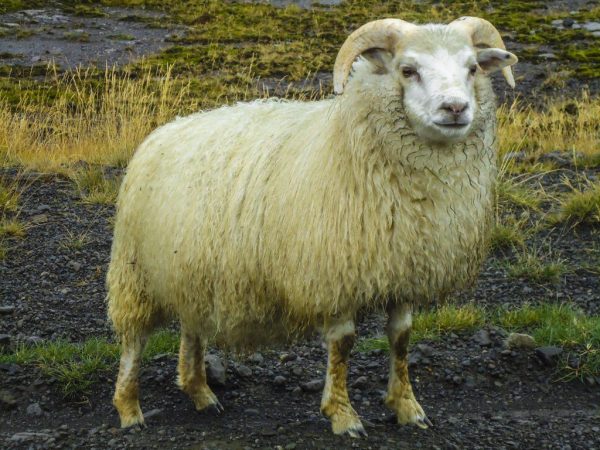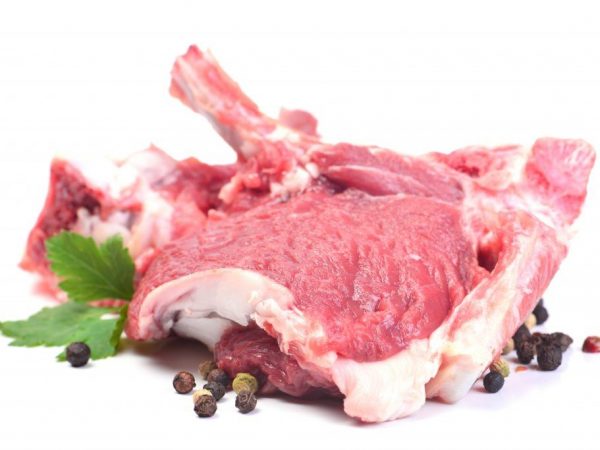How much does a ram weigh on average, net weight for meat
Depending on the purpose and direction of the breed, the indicator of how much a ram weighs ranges from 25 to 180 kg. The sex of the animal also influences the weight indicators: males significantly outnumber females in weight.
- Factors affecting live weight
- Weight of an adult ram of various breeds
- Fat-tailed breeds (meat-greasy)
- Sheeps of the fur coat direction
- Fine fleece rams
- Dwarf breeds
- What is responsible for the rapid growth of meat in rams?
- Meat output from one ram
- How much does a one-year-old ram weigh and how to calculate its weight

Ram
Factors affecting live weight
The following factors affect the net weight of the mutton and the rate of its gain:
- Direction and breed. Only rams of the meat direction are large in size and give a high yield of meat, while dwarf breeds weigh only about 20 kilograms, this is the average ram weight for such individuals.
- The sex of the animal. In all breeds, the average weight of a male significantly exceeds that of a sheep.
- Age. The maximum condition is reached at the age of 3-4 years. On average, a lamb of 4 months does not weigh more than 35 kg, even if it is ready for slaughter.
- Feeding and grooming also affects the live weight of the domestic sheep. Eating sheep is usually not a problem for farmers, but feed and vitamins are essential for good condition.
Weight of an adult ram of various breeds
Mass is related to the purpose of the animal. Depending on the products that farmers are focused on, sheep breeding is divided into:
- fine-fleece sheep breeding and semi-fine fleece, here the weight of the lamb itself does not really matter;
- meat-greasy, where the orientation goes to meat and fat (it is this breed that shows what real mutton weight can be obtained from a male);
- mixed sheep breeding - meat and wool, meat and dairy, fur coat, etc.
Fat-tailed breeds (meat-greasy)
These animals, which have warm coats, gain weight very quickly. Representatives of these breeds are the largest rams, the weight of which reaches 150-180 kg, and the maximum weight of a fat tail sheep reaches 200 kg. The largest animals are Hissar rams. The fat tail (fat on the rump) has a significant mass, and the wool is suitable only for technical purposes (making felt), since it is too coarse and short.
Sheeps of the fur coat direction
The weight of an adult ram of this breed is 110-120 kg. A distinctive feature of these breeds is the skin of excellent quality (the so-called sheepskin), ideal for making fur coats. The meat is in demand, but the wool of these rams is not highly valued, since its use is quite narrow. The most famous breed of fur coat is Romanovskaya.
Meat-wool rams (semi-fine wool). These sheep, with higher quality wool, gain weight quickly. The main feature of meat and wool sheep is the combination of high quality meat and excellent wool. On average, an animal weighs 100 kg. The most widespread are the North Caucasian, Kuibyshev and Tien Shan varieties.
Fine fleece rams
The purpose of breeding these breeds is the highest quality fleece. An adult weighs on average 70-80 kg. The most famous representatives are merino.
Dwarf breeds
They have a good quality fleece and good meat characteristics. The average weight of dwarf sheep is 18-20 kg.
The brightest representatives are the Wessent breed. One of the factors that have made sheep so popular is their early maturity, growth and low feed requirements.
What is responsible for the rapid growth of meat in rams?
Lambs are rapidly gaining weight even with a minimum of feeding costs. On grazing, they can gain an average of 300 g per day. This allows a young sheep to gain 80% of the body weight of an adult by one year of age.
To get the highest quality lamb with the best taste, you need to cut a one-year-old lamb. Not all breeders agree on the age of slaughter. Yablonovskiy M.Yu. I am convinced that the slaughter "... should be carried out at the age of 7-8 months, when the ram reaches 40-45 kg."
But in order for him to gain the necessary weight, he must be kept in suitable conditions and eat right. Even if feeding the lambs is not a big deal, the conditions must be respected.
To gain weight, you need the following:
- Correct diet. A young lamb should consume a sufficient amount of nutrients, vitamins and mineral supplements.
- Providing the necessary conditions of detention. Thanks to caring, animals avoid the risk of disease and loss of appetite.
- Timely veterinary service.
- Castration of individuals who are raised for the purpose of slaughter. Castration of a young male is performed at 6 months.
Castration goals:
- it allows you to improve the quality of meat, since the meat of an uncastrated male has an unpleasant odor and a pungent taste;
- it speeds up the process of gaining body weight of a valukha (castrated male), and also allows you to get by with less expensive feed and additives;
- no fights between castrated individuals;
- bled males are housed with sheep without risk, so farmers do not have to bear the cost of separation.
Meat output from one ram
When assessing the live weight of an adult, it must be borne in mind that after cutting the carcass, the net meat yield will be less. Now we will take a closer look at how to determine the net yield of lamb, and find out how many kilograms of pure meat you should count on.

Sheep meat
The lamb carcass is gutted, blood is released, the skin is removed, the head and legs are separated; a lethal yield of 38-50% remains, which is not a final loss. Additional cutting includes:
- deboning - removal of bones constituting 20-30% of the weight;
- inoculation - removal of tendons, cartilage, films, constituting 4-5% of live weight.
Net lamb yield (muscle mass) ranges from 64.5 to 70% of the carcass weight. So, if you take a ram weighing 100 kg, the slaughter yield from it is 38-50 kg, and the net meat yield from this individual is in the range from 24.5 to 35 kg.
It should be borne in mind that when buying an animal in live weight, the yield of pure meat will not exceed 65%. Not all farmers care about quality feed, and for a quick profit they include growth hormones in the diet, which reduces the quality of lamb. To avoid this, it is advisable to require a veterinary certificate.
Even taking into account the losses in the process of cutting carcasses, it can be concluded that there is a rather large benefit of raising sheep, especially meat-lard breeds, given the cost of mutton throughout the world, since the cost of feeding is minimal, and feed is readily available.
How much does a one-year-old ram weigh and how to calculate its weight
The term "lamb weight" applies specifically to the indicator of how much a one-year-old ram weighs. Most often this is a mass that ranges from 25 to 100 kg.
You can calculate the average weight of a one-year-old animal, the net weight of a ram, when comparing standard individuals of different breeds. Moreover, it is conditional. Weighing rams is often a challenge for farmers. Weighing is carried out by zootechnicians and veterinarians. Knowing the exact weight of each individual is necessary for both examination and treatment, vaccination.The weighing process is carried out using special pens with weights that allow you to fix the animal.
To obtain accurate data, you must comply with the following requirements:
- weigh in in the morning before feeding;
- take into account every kilogram in adults and every 500 grams in lambs;
- weigh regularly.
The information obtained allows you to calculate how much meat and wool will be obtained from each animal, as well as monitor the health and development of the lambs. It should be borne in mind that 10-15% of the mass falls on the horns. Take into account that the diet affects the quality indicators of mutton, the sufficient weight of a one-year-old individual. It is recommended to graze animals on meadow grasses, keeping them on oats, barley, bran with the addition of vitamins and in the absence of antibiotics.


